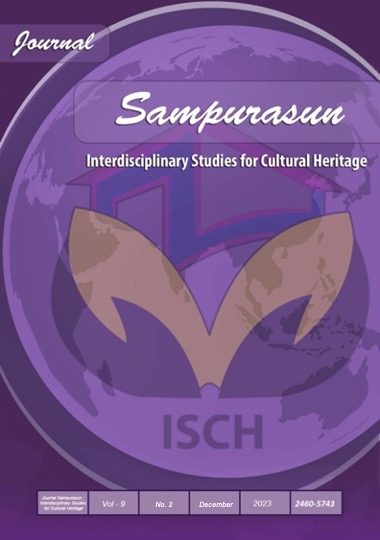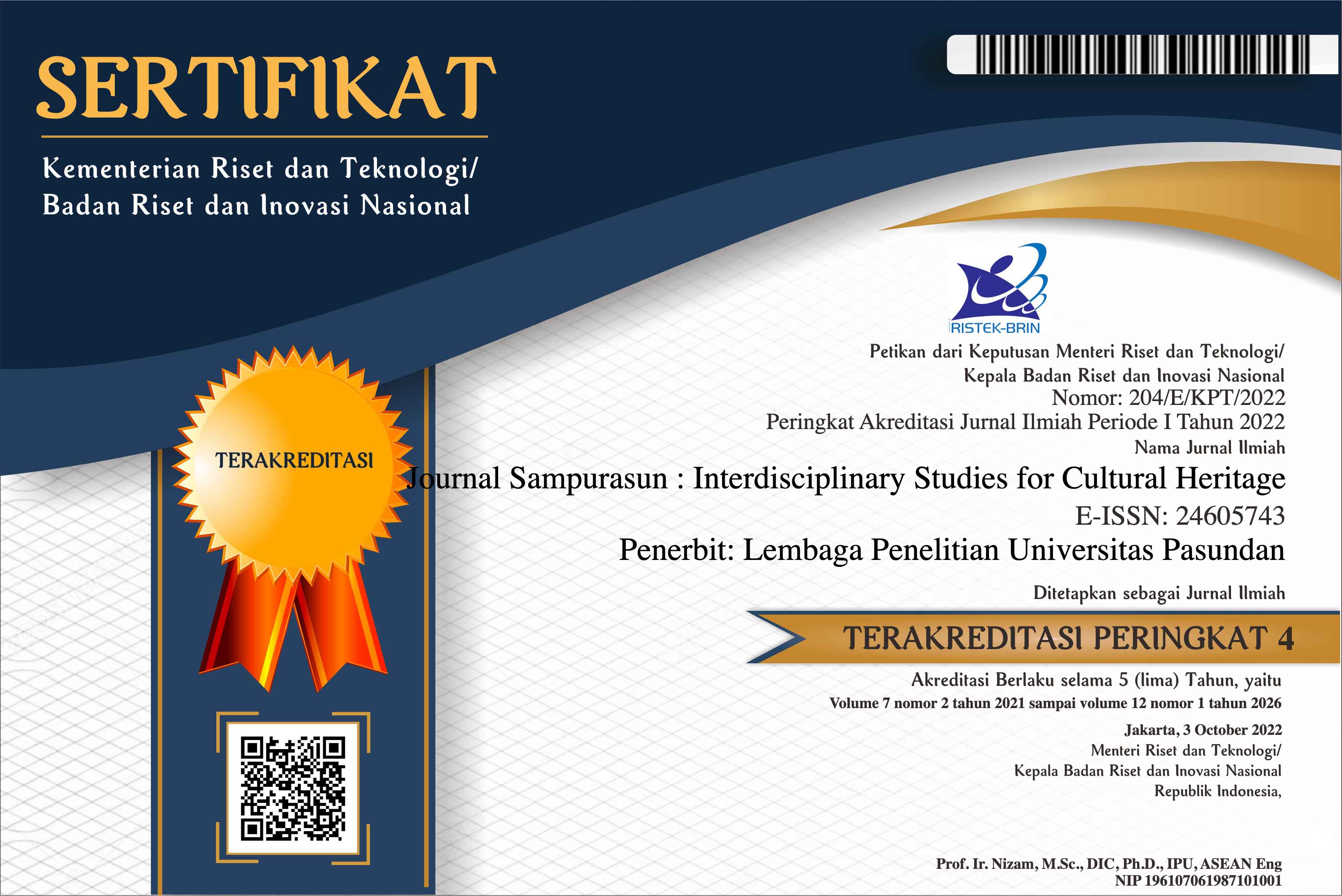Local Leadership Communications in the Tradition of Ngaruwat Bumi in the Traditional Village Of Banceuy, Subang District
DOI:
https://doi.org/10.23969/sampurasun.v9i2.10429Keywords:
Communication, Local Leadership, Ngaruwat Bumi, Traditional Village, Banceuy Subang DistrictAbstract
This research explains local leadership communication in the Ngaruwat Bumi tradition in Banceuy Village, Subang Regency. The description of the life of the Banceuy Village community as seen from local leadership based on social position and the social role of the actors in the Banceuy Traditional Village community is important in seeing the course of Ngaruwat Bumi rituals and traditions. This local leadership role is related to religion and belief which is centered on the Tatali Karuhun value system as a legacy of previous ancestral traditions. The myth of Dewi Sri, known as the spiritual figure Nyi Pohaci, was transformed into a rice plant, the staple food of the local community. So rice is considered a holy and sacred plant. This ritual is a way of honoring the existence of Dewi Sri (Goddess of Rice) who has given blessings to the lives of the people of Banceuy Traditional Village by dancing and singing Dewi Sri. The method used in this research is a qualitative method with a qualitative descriptive approach, through observation, literature study and interviews with traditional leaders of the Banceuy Indigenous village using purposive sampling techniques. The research results show that communication and the role of local leadership through the Ngaruwat Bumi ritual in Banceuy Subang Village is a local tradition that emphasizes the importance of ritual in fostering dialogue between humans and nature. This involves various aspects, including verbal, symbolic and social interactions, which aim to maintain and strengthen cultural identity and community values. These rituals also function as mediators of conflict between local residents and external authorities, increasing cultural awareness, environmental conservation, and social life.
Downloads
References
Afifah, S.N. 2016. Dinamika kehidupan Sosial- Budaya Masyarakat Tradisional Kampung Banceuy Desa Sanca Kabupaten Subang. (S1), Universitas Pendidikan Indonesia, Bandung.
Ainiyah, N. (2017). Peran Komunikasi Kelompok Berbasis Gender (Studi Akses Informasi Kelompok Perempuan Nelayan di Wonorejo, Banyuputih Situbondo, Jawa Timur). MUWAZAH: Jurnal Kajian Gender, 8(2).
Alfina, A. (2020). Komunikasi Gender Pegawai Saga Contractor Surabaya
Andayani, R. 2008. “Penolak Bala Pada Masyarakat Kampung Banceuy: Sawen” Jurnal Penelitian Edisi 40 April. Bandung: Balai Pelestarian dan Nilai Tradisional.
Andersen., K. E., (2000), Introduction to Communication Theory and Practice, Philippines: Cumming Publ Company.
Creswell, J. W. (2012). Educational research planning conducting and evaluating quantitative and qualitative research. Boston: MA Pearson.
Creswell, J. W. (2016). Research Design (4th ed). (Ahmad Fawaid & Rianayati Kusmini Pancasari, Penerjemah). Pustaka Pelajar
Daft, R. L. (2008). The Leadership Experience. USA: Thomson South-Western. Durant, W. (1953). The Pleasure of Philosophy : A Survey of Human Life and Destiny. California: Simon and Schuster.
Dalimunthe, S. F. (2016). Manajemen Konflik dalam Organisasi. Jurnal Unimed. Vol, 27, No.1
De Vries, R. E., Bakker-Pieper, A., & Oostenveld, W. (2012). Leadership= communication? The relations of leaders’ communication styles with leadership styles, knowledge sharing and leadership outcomes. Journal of business and psychology, 25(3), 367-380.
Endraswara, S. 2006. Metodologi Penelitian Kebudayaan. Yogyakarta: Gadjah Masa University Press.
Fauziah, S. 2017. Studi Etnografi Komunikasi Ritual Adat Masyarakat Kampung Pulo Desa Cangkuang Kecamatam Leles Kabupaten. Jakarta: Universitas Islam Negeri.
Hadi, Y.S. 2006. Seni dalam Ritual Agama.Yogyakarta: Pustaka
Kartono, D. K. (2009). Pemimpin dan Kepemimpinan . Depok: Rajawali Press.
Lexy J. M. (2005). Metolodogi Penelitian Kualitatif . Bandung: Remaja Rosdakarya
Liliweri, A. (2011). Komunikasi Serba Ada Serba Makna. Jakarta: Kencana Liliweri, A. (2015). Komunikasi Antar Personal. Jakarta : Prenadamedia Group. Littlejohn, S. W. (2017). Theories of Human Communication. Jakarta: Salemba Humanika.
Marvasti, A. B. (2004). QUALITATIVE RESEARCH IN SOCIOLOGY AN INTRUDOCTION. Thousand Oaks: Sage Publications.
Miles, M.B. dan A Michael H. 1992. Analisis Data Kualitatif. Jakarta: Universitas Indonesia.
Mukarom, Z. (2021). Teori Teori Komunikasi. Bandung: PT. Rosdakarya. Mulyana, D. (2007). Ilmu Komunikasi : Suatu Pengantar. Bandung: Remaja Rosdakarya.
Nalan, A.S. 1994. “Kosmologi Ngaruat: Antara Efikasi dan Persepsi”. Jurnal Panggung. Bandung: Pusat Penelitian dan Pengabdian kepada Masyarakat.
Nawawi, H. (2004). Kepemimpinan yang Efektif. Yogyakarta: Gadjah Mada University Press.
Saleh, M. (2016). Komunikasi Dalam Kepemimpinan Organisasi. Malang: Universitas Brawijaya Press.
Sendjaja, S. D. (1996). Pengantar Ilmu Komunikasi . Jakarta: Universitas Terbuka. Sendjaja, S. D. (2007). Teori Komunikasi. Jakarta: Universitas Terbuka
Siagian, S. P. (2003). Teori dan Praktek Kepemimpinan. Jakarta: Rineka Cipta.
Sugiyono. (2014). Metode Penelitian Pendidikan Kualitatif, Kuantitatif dan R&D. Bandung: Alfabeta
Sugiyono. 2014. Memahami Penelitian Kualitatif. Bandung: Alfabeta.
Suranto, A. (2011). Komunikasi Antarpribadi. Jakarta: Universitas Terbuka. Sutarto. (1998). Dasar Dasar Kepemimpinan Administrasi . Yogyakarta: Ggajah Mada University Press.
West, T. &. (2017). Pengantar Ilmu Komunikasi Analisis dan Aplikasi. Jakarta: Salemba
Widjaja, D. H. (2008). Ilmu Komunikasi Suatu Pengantar. Jakarta: Rineka Cipta
Downloads
Published
Issue
Section
License
Copyright (c) 2023 Journal Sampurasun : Interdisciplinary Studies for Cultural Heritage

This work is licensed under a Creative Commons Attribution 4.0 International License.
Copyright Notice
Authors should not withdraw their submitted papers because the withdrawal wastes voluntary works devoted by an associate editor and reviewers. But, we accept the withdrawal of a submitted paper if authors have unavoidable reasons. In the event that a manuscript is to be withdrawn from submission to Sampurasun Journal, a letter must be sent to the editorial office requesting withdrawal by e-mail (sampurasunjournal@unpas.ac.id) with its scanned PDF file, before the notification of acceptance for publication.
The withdraw request letter must include the following information. Paper ID, Paper title, Authors names, Reason why the paper must be withdrawn, and Date and signatures of all the authors (or signature of the contact author).
If only the contact author signs the letter, he/she must obtain the agreement of the withdrawal from all the other authors and the letter must include the description that all the other authors agreed the withdrawal. The journal will not withdraw a manuscript from peer review until such a letter has been received. Authors must not assume their manuscript has been withdrawn until they have received appropriate notification from the editorial office. Withdrawal of a manuscript subsequent to acceptance for publication will only be granted in the most exceptional of circumstances.
After the paper is accepted for publication, the withdrawal is not permitted in principle. The authors must always pay the charge even if the withdrawal is permitted. Any request of withdrawal that does not follow the above procedure is treated as invalid. If illegal submission, e.g., plagiarized or duplicate submission, is found for a paper, the withdrawal of the paper will never be permitted and the authors will be punished based on the rule. It is not acceptable practice to withdraw a manuscript in the event of acceptance at another journal. This constitutes dual submission. The editorial office of the other journal will be notified of your actions. In such circumstances Sampurasun ISCH may chose to impose appropriate punitive action subject.
Withdrawal Penalty
Author is not allowed to withdraw submitted manuscripts, because the withdrawal is waste of valuable resources that editors and referees spent a great deal of time processing submitted manuscript, money and works invested by the publisher. If author still requests withdrawal of his/her manuscript when the manuscript is still in the peer-reviewing process, author will be punished with paying $200 per manuscript, as withdrawal penalty to the publisher. However, it is unethical to withdraw a submitted manuscript from one journal if accepted by another journal. The withdrawal of manuscript after the manuscript is accepted for publication, author will be punished by paying US$500 per manuscript. Withdrawal of manuscript is only allowed after withdrawal penalty has been fully paid to the Publisher. If author don't agree to pay the penalty, the author and his/her affiliation will be blacklisted for publication in this journal. Even, his/her previously published articles will be removed from our online system.


















